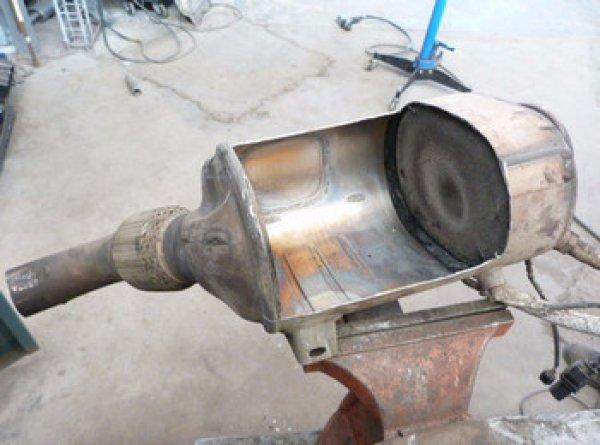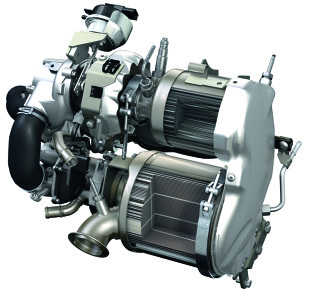
Particulate filter. Cut or not?
 Turbo diesel particulate filters usually do more harm than good, adding huge costs. Usually they are cut off, but this is not the best solution.
Turbo diesel particulate filters usually do more harm than good, adding huge costs. Usually they are cut off, but this is not the best solution.
 The history of automotive filters, which capture particulate matter from exhaust gases - soot and ash, dates back to 1985. They were equipped with three-liter turbodiesels on Mercedes, which were then sold in California. Since 2000, they have become standard in cars of the French concern PSA, and in subsequent years they were increasingly used in cars of other brands. These types of filters installed in diesel exhaust systems are called DPF (from the English "diesel particulate filter") or FAP (from the French "filter particles").
The history of automotive filters, which capture particulate matter from exhaust gases - soot and ash, dates back to 1985. They were equipped with three-liter turbodiesels on Mercedes, which were then sold in California. Since 2000, they have become standard in cars of the French concern PSA, and in subsequent years they were increasingly used in cars of other brands. These types of filters installed in diesel exhaust systems are called DPF (from the English "diesel particulate filter") or FAP (from the French "filter particles").
Two different standards have been adopted for diesel particulate filters. The first is dry filters, which do not use additional liquid to reduce the temperature of soot combustion. Combustion occurs by appropriately controlling the injection and supplying more fuel at the right time to produce a higher exhaust gas temperature and burn off pollutants accumulated in the filter. The second standard is wet filters, in which a special liquid dosed at the time of combustion of exhaust gases reduces the combustion temperature of deposits in the filter. Afterburning usually involves the same injectors that supply fuel to the engine. Some manufacturers use an additional injector designed only to clean the filter by burning particulate matter.
In theory, everything looks perfect. Particles of soot and ash enter the filter, and when it is filled to the appropriate level, the electronics indicate the need to burn pollutants. The injectors deliver more fuel, the exhaust gas temperature rises, soot and ash burn out, and everything returns to normal. However, this only happens when the vehicle is moving in changing road conditions - both in the city and off-road. The fact is that the process of burning the filter requires several minutes of driving at a constant, fairly high speed, which is possible only on a highway. There is practically no such opportunity in the city. If the vehicle is only driven for short distances, the burnout process will never be complete. The filter is overfilled, and excess fuel flows down the cylinder walls into the crankcase and dilutes the engine oil. The oil becomes thinner, loses its properties and its level rises. The fact that the filter needs to be burned is signaled by a light indicator on the dashboard. You can’t ignore it, it’s best to go out of town and make a fairly long journey at the recommended speed. If we do not do this, you will have to go to the service center to burn out the filter in the workshop and change the oil with new one.
The editors recommend:
- Fiat Tipo. 1.6 MultiJet economy version test
- Interior ergonomics. Safety depends on it!
– Impressive success of the new model. Lines in salons!
Failure to comply with this requirement leads to the worst-case scenario - complete clogging of the particulate filter (the engine only runs in emergency mode, the filter must be replaced) and the possibility of "wiping" or complete jamming of the engine. We add that problems with the filter appear at different mileage, depending on the model of the car and its mode of operation. Sometimes the filter works flawlessly even after 250-300 thousand km, sometimes it starts acting weird after a few thousand kilometers.
A huge number of drivers use cars to travel short distances. Cars are often used only for commuting to work or school. It is these users who are most affected by the problems associated with the particulate filter. Spending on websites is spending their wallets, so it's no wonder they're looking for an option to remove the ill-fated filter. There is no problem with this, because the market has adapted to realities and many repair shops offer services that consist in cutting out a problematic element. However, it should be noted that removing the particulate filter is illegal. The regulations say that it is not allowed to change the design of the car specified in the terms of agreement. And these include the presence or absence of a particulate filter, which is also noted on the nameplate. But desperate car owners ignore the law for the sake of their finances. A new particulate filter costs from a few to PLN 10. The consequences of his underburning are even more expensive. Therefore, they go to thousands of workshops that offer the service of cutting the DPF filter, knowing that the discovery of this fact by the police on the road, or even by a diagnostician during a periodic technical inspection, is almost a miracle. Unfortunately, not all mechanics are fair, and in many cases, removing the filter is also problematic.
 A particulate filter can be cut for a few hundred zlotys, but removal alone will not solve the problem. There remains the issue of electronics. If it is left unchanged, the engine management system will record its absence. After trimming, the machine can drive with full power and not signal any problems with the indicator light. But after some time, he will ask you to burn the physically absent filter and put the engine into emergency mode. There will also remain the problem of "pumping" additional fuel into the cylinders and diluting engine oil.
A particulate filter can be cut for a few hundred zlotys, but removal alone will not solve the problem. There remains the issue of electronics. If it is left unchanged, the engine management system will record its absence. After trimming, the machine can drive with full power and not signal any problems with the indicator light. But after some time, he will ask you to burn the physically absent filter and put the engine into emergency mode. There will also remain the problem of "pumping" additional fuel into the cylinders and diluting engine oil.
Therefore, when deciding to cut the particulate filter, you need to contact a reputable workshop that will provide full professionalism for such a service. This means that in addition to removing the filter, it also effectively adapts the electronics to the new situation. Either he will update the engine driver software accordingly, or he will introduce the appropriate emulator into the installation, in fact "cheating: the on-board electronics." Garage customers are sometimes scammed by unreliable mechanics who either can't or don't want to change electronics even though they charge money for it. For a professional particulate filter removal service with the installation of an appropriate emulator, you will have to pay from PLN 1200 to PLN 3000, depending on the car model. In our realities, the absence of a particulate filter is difficult to detect. Even a physical inspection of the exhaust system by a policeman or diagnostician does not lead to the conclusion that the filter has been cut. Smoke measurements during periodic technical inspection at the diagnostic station will also not allow detecting the absence of a filter, because even an engine with a particulate filter cut out will comply with current standards. Practice shows that neither the police nor the diagnosticians are particularly interested in DPF filters.
It is worth recalling once again that the removal of the particulate filter is illegal, although so far with impunity. If someone is not convinced by the law, perhaps ethical considerations will. After all, DPFs are installed for the sake of the environment and the quality of the air we all breathe. By removing such a filter, we become the same poisoners as those who burn plastic bottles in ovens. Already at the stage of choosing a car, you have to consider whether you really need a turbodiesel and whether it is better to opt for a gasoline version. And if we buy a car with a diesel engine, we must put up with the presence of a diesel particulate filter and immediately focus on following the recommendations that guarantee its trouble-free operation.